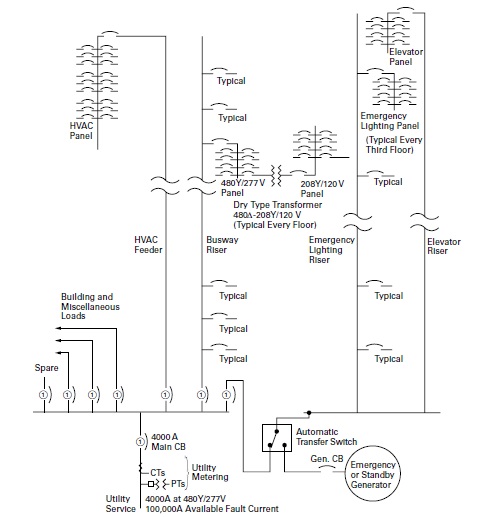With most low-voltage services, the service
voltage is the same as the utilization voltage. However, when the engineer is
faced with a decision between 208Y/120 V and 480Y/277 V secondary distribution
for commercial and institutional buildings, the choice depends on several
factors. The most important of these are the size and types of loads (motors,
fluorescent lighting, incandescent lighting, receptacles) and length of
feeders. In general, power system designs with HVAC equipment with a significant
quantity of motors, predominantly fluorescent lighting loads, and long feeders,
will tend to make 480Y/277 V more economical.
Industrial installations with
large motor loads are almost always 480 V resistance grounded, wye systems (see
further discussion on this topic in the Grounding/ Ground Fault Protection section of this Design Guide).
Practical Factors
Because most low-voltage distribution equipment
available is rated for up to 600 V, and conductors are insulated for 600 V, the
installation of 480 V systems uses the same techniques and is essentially no
more difficult, costly or hazardous than for 208 V systems. The major
difference is that an arc of 120 V to ground tends to be self-extinguishing, while
an arc of 277 V to ground tends to be self-sustaining and likely to cause severe
damage.
For this reason, Article 230.95 of the National Electrical Code
requires ground fault protection of equipment on grounded wye services of more
than 150 V to ground, but not exceeding 600 V phase to-phase (for practical purpose,
480Y/277 V services), for any service disconnecting means rated 1000 A or more.
Article 215.10 of the NEC extends this equipment ground fault requirement to feeder
conductors and clarifies the need for equipment ground fault protection for
1000 A and above, feeder circuit protective devices on the 480/277 Vac secondary
of transformers. Article 210.13 has been added to the 2014 NEC, essentially
recognizing the same need for equipment ground fault protection on 1000 A
branch circuits being fed from the 480/277 Vac secondary of transformers.
The
National Electrical Code permits voltage up to 300 V to ground on circuits supplying
permanently installed electric discharge lamp fixtures, provided the luminaires
do not have an integral manual switch and are mounted at least 8 ft (2.4 m)
above the floor. This permits a three-phase, four-wire, solidly grounded 480Y/277
V system to supply directly all of the fluorescent and high-intensity discharge
(HID) lighting in a building at 277 V, as well as motors at 480 V.
Technical Factors
The principal advantage of the use of higher
secondary voltages in buildings is that for a given load, less current means smaller
conductors and lower voltage drop. Also, a given conductor size can supply a
large load at the same voltage drop in volts, but a lower percentage voltage
drop because of the higher supply voltage. Fewer or smaller circuits can be
used to transmit the power from the service entrance point to the final distribution
points. Smaller conductors can be used in many branch circuits supplying power
loads, and a reduction in the number of lighting branch circuits is usually
possible.
It is easier to keep voltage drops within acceptable limits on 480 V
circuits than on 208 V circuits. When 120 V loads are supplied from a 480 V system
through step-down transformers, voltage drop in the 480 V supply conductors can
be compensated for by the tap adjustments on the transformer, resulting in full
120 V output. Because these transformers are usually located close to the 120 V
loads, secondary voltage drop should not be a problem. If it is, taps may be
used to compensate by raising the voltage at the transformer.
The interrupting
ratings of circuit breakers and fuses at 480 V have increased considerably in
recent years, and protective devices are now available for any required fault
duty at 480 V. In addition, many of these protective devices are current
limiting, and can be used to protect downstream equipment against these high
fault currents.
Economic Factors
Utilization equipment suitable for principal
loads in most buildings is available for either 480 V or 208 V systems.
Three-phase motors and their controls can be obtained for either voltage, and
for a given horsepower are less costly at 480 V. LED lighting as well as earlier
technologies including fluorescent, HID and high pressure sodium can all be applied
in either 480 V or 208 V systems. However, in almost all cases, the installed equipment
will have a lower total cost at the higher voltage.
 |
| Figure 1.1-23. Typical Power Distribution and Riser Diagram for a Commercial Office Building |




No comments:
Post a Comment